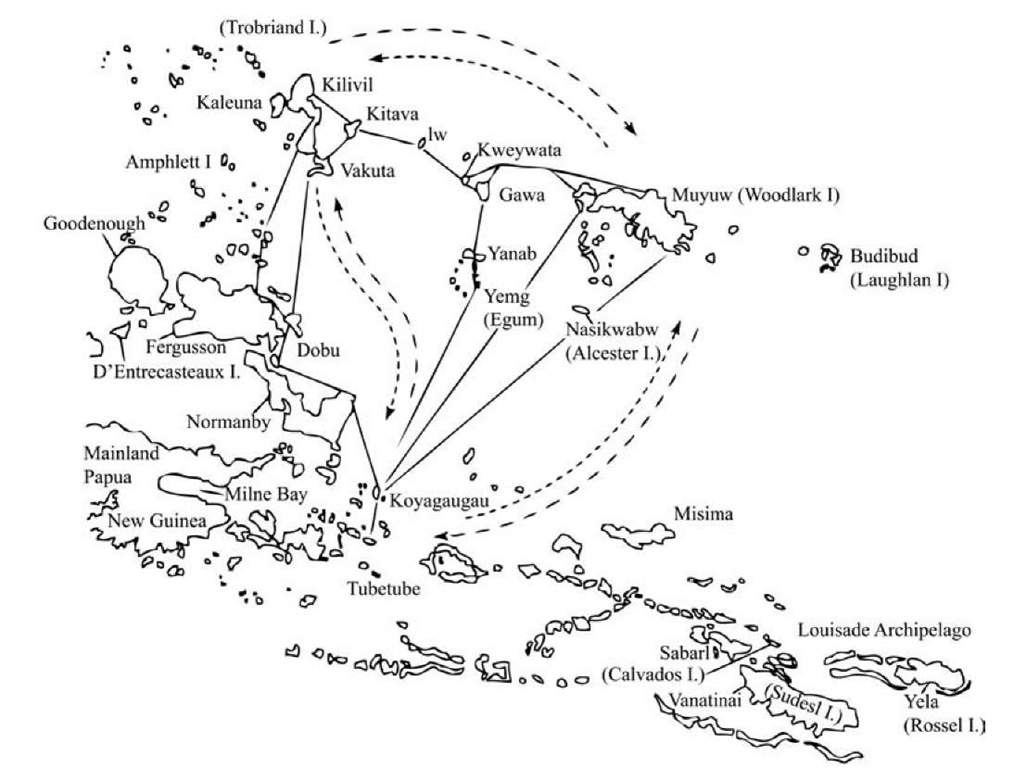The kula system is an exchange system in Melanesia. In kula people rank themselves by exchanging two sets of shell valuables, counterclockwise circulating mwal and clockwise circulating bagi, through a circle of island cultures in Southeastern Papua New Guinea. The institution has been central to twentieth-century anthropological theories about society, ‘primitive’ and ‘modern’, ‘non-Western’ and ‘Western’, ‘reciprocity-based’ versus ‘market-based’ and ‘gift’ versus ‘commodity’.
Although partially described by late nineteenth and early twentieth-century observers, Bronislaw Malinowski carved it into the anthropological imagination with Argonauts of the Western Pacific (1922), a monograph written to shatter existing theories and stereotypes and reformulate what then existed of anthropological methodology. Marcel Mauss immediately reinterpreted Malinowski’s data in The Gift (1990; Essai sur le don [1924]). Both works appeared as anthropology was becoming professionalized and at a time when Western intellectuals were forced to re-examine certainties eclipsed by the horrors of World War I. The kula’s eminence derives partly from the role it played in both processes. Although Malinowski thought he was describing something unique, Mauss discussed similar institutions through time and space. Together these two fashioned kula, along side the potlatch, as the ethnographic prototype for theories about reciprocity. Malinowski inspired much of British anthropology’s functional-ism. Mauss’s reinterpretation launched Levi-Strauss’s structuralism and exchange theory. Although the ethnography was reworked (e.g. Uberoi 1962), theoretical constructs built from Malinowski, Mauss and Levi-Strauss lasted into the 1970s (Ekeh 1974) when new kula data played a role in redefining these theories.
Map 1 The Kula Ring Standard English names in parentheses
The Trobriand Islands provided the setting for Malinowski’s description. ‘Kula’ is a Trobriand word. In nearby islands cognates are kun, kune, and related practices called niune (Young 1985). These words may be used as nouns, noun classifiers for counting kula valuables, and as verbs encompassing activities epitomized by the shell exchanges.
Many consequences follow from kula activity. These run from distributing different products among ecologically and socially diverse islands to warfare, witchcraft, and murder. Yet, the institution’s expressed purpose is to create a person’s ‘name’ or ‘fame’, this being realized by the exchange of the two sets of ranked objects along a ‘road’ or line of people.
A thousand or more of each valuable move in two waves. It may take four or five years for a crest to circle the course, but every year smaller numbers of valuables precede and follow each crest. Although actors describe kula as circular, some valuables continue to leak out of the system and others are traded into neighbouring cultures. Hence the fashioning of new ones.
Although exchange rules vary among the islands, the basics are simple. When one person gives a mwal to another, the recipient must return a commensurately sized bagi. The return ends the relationship created by the initial object. Since the desired name or fame derives from relationships, actors struggle to transcend basic exchange rules. They do this by returning valuables of different sizes, returning more than they owe, or delaying returns for as long as possible. These strategies become very complex. The simple going and coming of a few valuables defines younger participants’ ties. Experienced actors, however, embed themselves in networks as tangled by new links as they are by redefined older ones.
To create a successful kula relationship people build other productive and exchange relationships, ultimately tying together an area’s ecological and social diversity. Eventually a whole community flows into a successful person. Consequently, all exchanges are public. As the most important form of wealth in these societies, kula valuables and their paths are visible signs of persons understood in relation to multiple others.
The exchange items have distinctive appearances and meanings. Mwal are cut from the broad end of a conus shell (Conus leopardus). Natural spots are polished off new ones until they are white. Bagi are made from small red pieces of shells (Chama (pacifica) imbricata) strung through locally produced string and ground to a round glassy texture. New necklaces approach a metre in length, individual shell pieces several centimetres in diameter. People rank the valuables, the highest being more decorated and carefully handled than the lowest. Makers or first owners name all but the lowest ranked. Successful traders name children with the highest. Kula articles are personified. The smallest are likened to irresponsible youths whose ties rarely endure, the largest to mature, wise elders who move only in well-defined paths. Most islanders assert that mwal are male, bagi female. The completed exchange of one for the other is likened to marriage. Marriage varies among the islands, but everywhere it organizes male and female labours. Personified kula valuables and relationships draw from ideas about marriage, for kula too is a (if not the) major productive activity.
Why and how one valuable has to be returned for its complement is the kula’s major analytical problem. Theories of reciprocity provided one answer. New research contributed others through the discovery of the kitoum concept, another way of classing the objects (see essays in Leach and Leach 1983, and Weiner 1992). Kitoum, or close cognates, mediate the mwal/bagi distinction since both can be equated to it, though not to each other. Further, they facilitate reciprocal conversions among products, persons and kula articles.
Excepting Rossel Islanders, the traditional bagi makers, all kula people speak Austronesian languages. These language speakers arrived in the region 2—3,000 years ago coincident with the expansion of Austronesian populations into Polynesia. Long-distance trade was a characteristic of such peoples, but when kula started is not known. European expansion simplified indigenous cultures. Although late twentieth-century kula remains a leading passion, its underlying conditions have changed significantly since 1900 and earlier.

